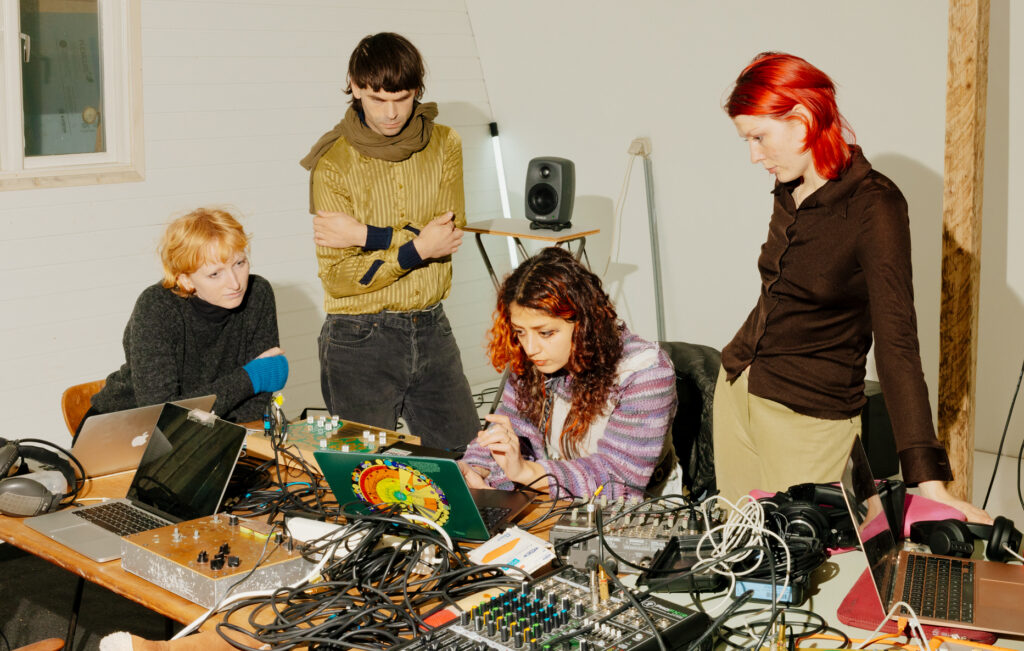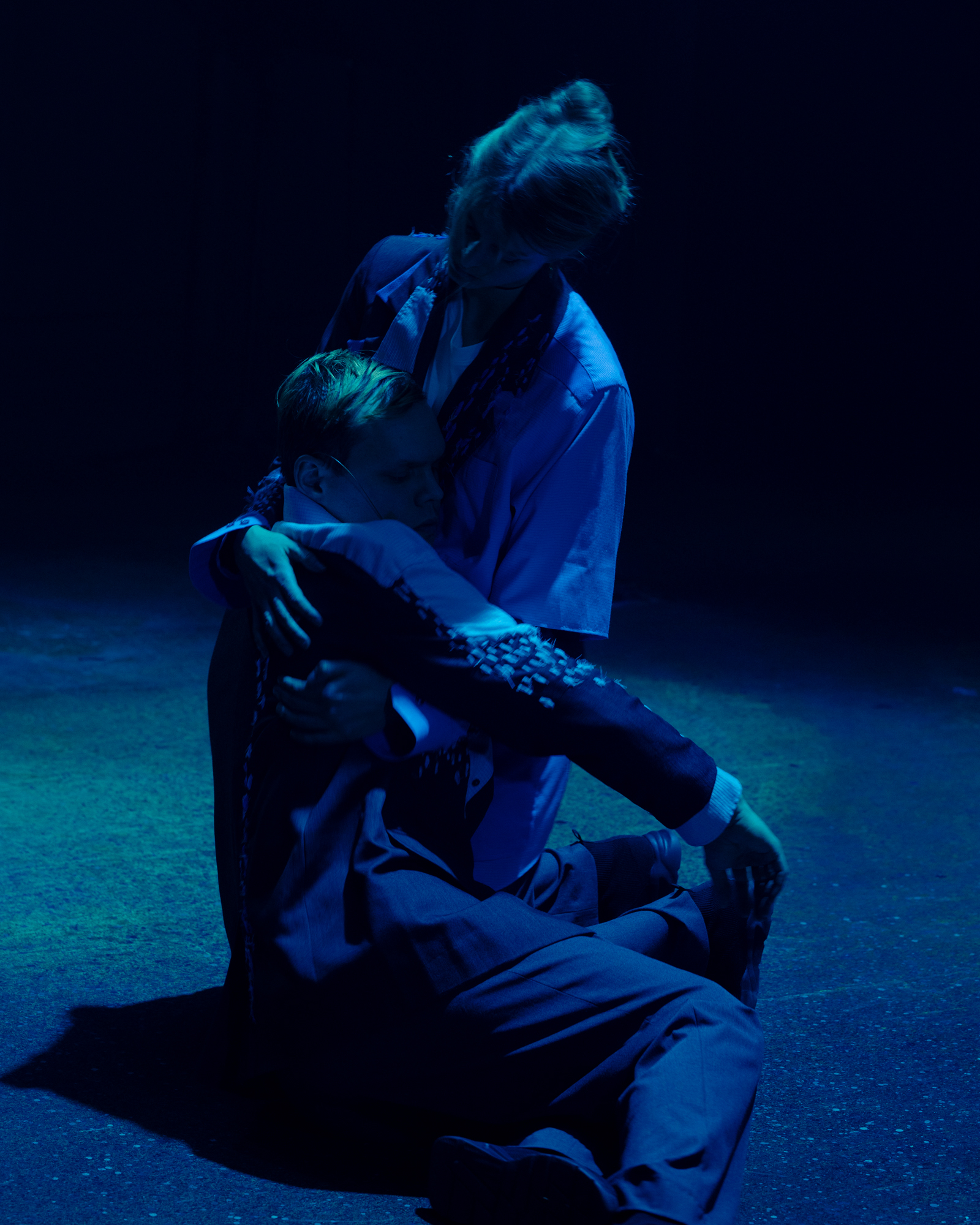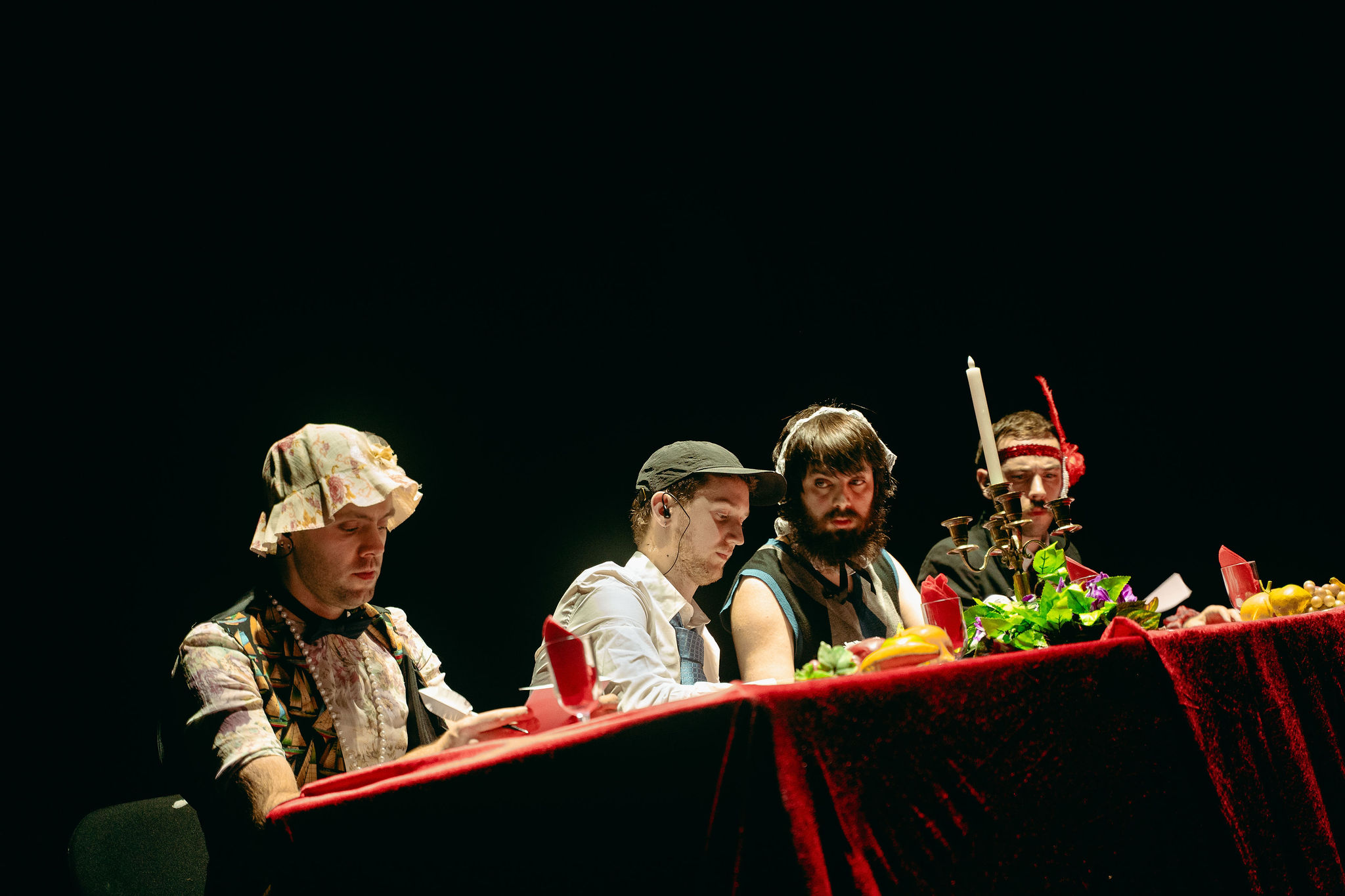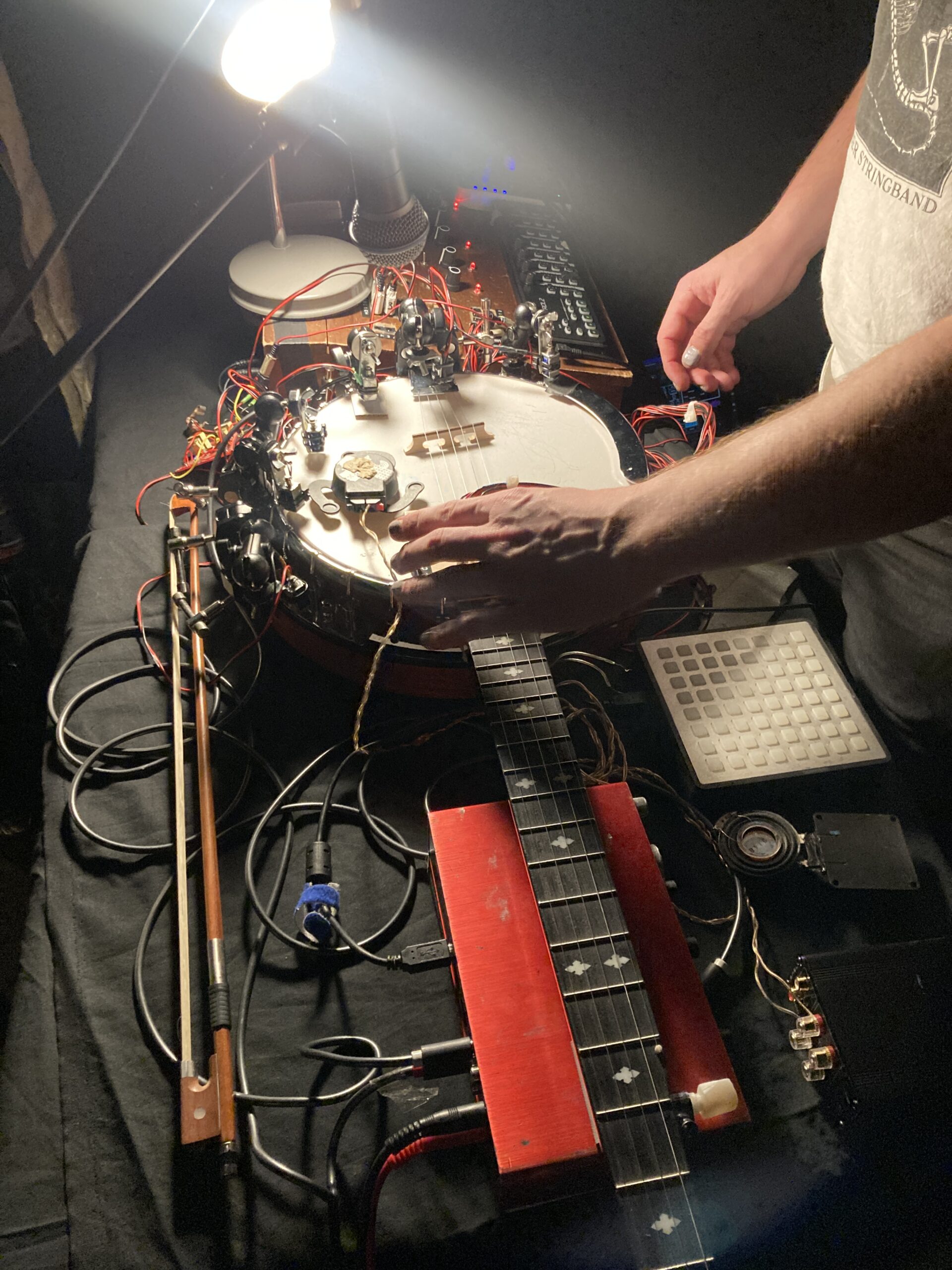Becoming MINU 2023
„You remove the trapdoor and walk down wooden stairs.
You enter an intimately lit room. The room is covered in grass, including the walls and ceiling.
The sound is louder now, and you walk towards it.
It’s a soft and tender sound of someone slurping soup.
But in a cute way.
As you get close, you realize that the sound is coming from a little animal, relaxing in the grass.
It has fur and four legs, but something about it seems otherworldly, like it’s a made-up animal, a children’s drawing.
Reneé, Destroyer of Worlds, do you leave the animal or take it with you?
TAKE”
(Tobias Sejersdahl, Becoming Glass)
Tiny white letters appear on the black screen word after word, as in the vintage computer text game. The quest of Becoming Glass by Tobias Sejersdahl is to transform your flesh into glass, of course if you make the right choices in a series of adventures. “Renée, destroyer of worlds, bringer of doom” player usually makes such. In the background there is still some subtle, sometimes ambient, sometimes glitchy, soundscape, but never too illustrative. Sometimes you have to imagine sounds yourself, as in the moment quoted above, otherworldly animal slurping soup. It’s rather a witty and surreal narrative that propels this piece of music. You are in Xenon, a venue on the fourth floor of Copenhagen’s HUSET, a multi storey cultural centre with a history. And that’s the last show of the first day of MINU_festival_for_expanded_music. A lot of underscores. What’s your quest here? To expand your horizons? To get some new stuff or people from the local scene? To experience or feel something?
Are you ready to play MINU?
YES
Do you need instructions?
YES
MINU_festival_for_expanded_music is a Copenhagen-based festival presenting art on the borders of new music and other media. It is a space for oscillating between extremes and charting relationships between art, technology, and contemporary culture. With a curatorial focus on the events as holistic experiences, MINU is an initiative for expanding the definition of music through presenting the unmusical as musical. […] MINU 2023 has only one kind of ticket available: a festival ticket that gives access to all 10 concerts at the festival priced at 150 kr. It’s important for us to present events that are accessible to everyone regardless of financial means. We want to encourage audiences to visit multiple events, therefore access to all concerts on the festival is included when you purchase a ticket.
Choose you name:
☐
150 Kr. You can’t even buy a dinner for that here. So yes, it’s accessible. The young festival is shockingly open in other areas as well: the whole budget of the 2022 edition is online (!) and the curator Mikkel Schou made a pitching session for projects for the 2023 edition. Do you know other events programmed like that? One ticket for all means there are some regulars as well. You could feel a sense of small community already at the second concert, even if you’d fear you would be just an outsider from Poland. MOOD 70. So you look for other ones. Olga Szymula also came here from your country, but it was a long time ago and she is already well established in the Danish scene. Her piece re- opens the festival performed by K!ART ensemble of four, including Mikkel. Other curator of MINU, Dylan Richards, with Current Resonance group closes the lineup five days later. I like this kind of hosting and framing, it builds a sense of personal touch. As well as brief and entertaining descriptions in the festival booklet.
You got commission for a new work, full-evening, opening of a new festival in the capital. You feel excited and rewarded. MOOD 100. You want to know the people who will perform it, so you meet them one and other time, all together and one by one. You listened to their stories and backgrounds. Rob Durnin is playing a synthesiser and Mikkel Schou guitar. But that’s not an indie band, it’s the Copenhagen K!ART ensemble, completed by clarinettist Joss Smith and percussionist Hsiao Tung Yuan. They preserved their passion and playfulness, they really like to cross boundaries of music. So you begin to make silly films with them in a studio with bluescreen. You even design nice pyjamas for everyone, so they are characterised by colours and instruments. Then you cut and copy, edit and edit video, having in mind there should be live action as well. Some sort of play with the video, reenactment and reinterpretation of what you see and hear. But should there be a lot of these amusing texts or stories you heard? YES or NO
NO
And that was so damn right choice, Olga. The opening piece of MINU 2023 wins with all its ambiguities and understatements. I am taken to a Ferris wheel of emotions, from laughs at slapstick gags (when they dance with a tam-tam) through the thrills of vulnerability (when they run up to us, time after time, trying to sing) to embrace of community (when they hug or support each other). Sometimes all these emotions are mixed at one moment. I feel what it means to belong to the group, draw strength from it but also to fear loneliness or rejection. MOOD 50 or 100. And all that is embodied in movement, hardly any instrument playing, even if all sounds so musical. So, how could you plan or program pieces like this? How do you complete a lineup and discover you got, surprise surprise, composer in residence? Jessie Marino just became one – officially invited for one gig, then her other piece was included in Plus-MINUs ensemble repertoire. And she squeezed herself into playing a duo with accordionist Andreas Borregaard instead of writing a solo piece for him. You have minimum time, you need maximum control. What could you do? Give up solo or play a duet? DUET. It’s quite obvious.
So, are you excited at the MINU’s highlight, NYA LÅTAR by James Black?
FUCK, YES!
Then you are eating just before the concert, not to think about food later. TIME: 80. MOOD: 60. You choose your cheap noodles and then you just wait and wait in a bar far away from the venue, as the cook completes an infinite row of take-away orders. TIME: 60.
Eventually you got it: tofu, broccoli, champignons, ginger and sesame, all yummy. MOOD 80.
You run to the bus to catch the METRO. The weather is like that all day, driving rain. MOOD 70, TIME 50.
Down there you meet a suspiciously large crowd of passengers. “Due to water in the tunnel there is no service between… Replacement buses are waiting at metro stations…”. TIME 40.
You take a lift up, and look around in fever. So, would you spend all your money for a taxi, try to install an app to rent a bike or wait for the bus?
TAXI
“All our drivers are busy…” MOOD 40. TIME 20.
It rains like hell.
NYA LÅTAR is approaching. You could read on the festival website “Marie Sanderskøv is late for work, but she doesn’t mind at all…”
BUS
You go down the metro station again, take one stop, then up. Whole crowd tries to pack into a single bus. Driver shouts something in Danish. It takes hours. TIME 10. MOOD 20.
And the bus is circling to get to all metro stations closed. TIME 0.
But maybe they would delay the concert? You are still half an hour away though.
TIME -10. MOOD 10.
“…she does things at her own pace”. You tried it too.
Sometimes you just can’t make it: in bad weather and an unknown city… Fortunately enough, you know James from some previous festivals, so you just can ask him if they’d record any bit of the performance. Luckily, yes, they had! However, taken from the mobile phone, with the festival’s photographer standing for minutes just in front of it. Alternative take on the event indeed. You could only make the general impression of NYA LÅTAR: a mix of Scandinavian songbook, new-age vibes and The Office-kind of sitcom starring NYJD players and Black themselves. Composer impersonates a visionary boss pushing his staff to build new pyramids (literally!), so the tension arises in the staff and even a 10-minute song on love could relieve it only partially. As you can guess from the libretto, there is tons of irony in that, although it maybe lacks some content on the other hand?
Cute sock puppets performing in Black’s NYA LÅTAR, colourful pyjamas in Szymula’s re–, home environments with blankets and lightbulbs in Rob Durnin’s Nativity – all these are signs of MINU’s dominant DIY aesthetics. I read it not only as a budget restriction, but also as a manifesto in opposition to all high-tech concert design or audio-visual installations. On my way to Durnin’s performance in Teaterøen, far away in the former harbour area, I visited one of those. Copenhagen Contemporary hosts an immersive exhibition Yes, It Moves with monumental trilogy dataverse by Ikeda. I am almost drawn into three huge screens displaying datasets, maps and animation, with smooth multichannel electronics (nevertheless how impressive it is).
“The city beliethed foursquare of length’s breath, encased of walls jasper, pure gold city unto a paragonal glass whose foundations garlanded cherubate stones in precocian: chalcedony, sardonyx, sardius, chyrsolite, chrysoprasus, ad etceterus. O pearlescent gates bemantling dodecaccord its crown, sacrisans tempus; all shining nomers bespurn
ere the vainglory belightening, media lamb’s light thereof.” (Rob Durnin, Nativity)Did you get it?
NO
In total opposition to such an excess, Durnin begins his diploma concert for 12 people sitting on the floor in the dark. In the first part Nikolaus von Bemberg is reciting surreal texts, playing with props like DVDs, recorder, metronome or synth placed vertically – it is so intimate and fragile. In following parts titled Communion or VLCLitany Connor McLean and Neli Pantsulaia who act like Mary and Joseph in minimal settings of a well known religious scene. Reductionist play of recorder, pianos and voices, mixed with lights and mirrors, sometimes intrigues, sometimes bores, also because of the text’s unintelligibility. Maybe a written libretto would help us in reception?
Even so, I am quite in the MOOD 80 this evening, also because just before the performance I spotted the seal, resting peacefully at the pier just in front of Teaterøen. Although Nativity lasts only 45 minutes or so, the seal is already gone on my way back. MINU’s curators in their statements underline the focus on integrity of the event and that was the case with most of the program (with a notable exception of Cyborg Soloists concert by Plus-MINUs Ensemble). In Blaagaard Theatre we are given the booklet before another evening full of songs. Kirstine Fogh Vindele took the title and text of her WE JUST WORK HERE WE DON’T MAKE RULES from an “extensive conversation with employees in the Danish asylum system”. The mix of terrifying and amusing at the same time brought me memories of Matthew Shlomowitz Jennifer Walshe’s Minor Characters, new discipline exorcism on #metoo presented this year in Darmstadt.
“It is difficult to apprehend people in an airplane. There isn’t a lot of room, so you need to bring them to the aisle and do it in front of a flight full of people. It isn’t super easy and it doesn’t look so good. It’s just a regular passenger flight we board with. The pilot doesn’t want the ordinary people, who are on their way to vacation to be disturbed, or to feel unsafe. We need to make sure their airways are unobstructed. If we sit on them so that we flatten their lungs, so that they can’t breathe. And if they’re agitated at the same time, they will hyperventilate and then they will faint. So it’s super important that when we apprehend them and hold them down, that we walkway maintain control of the breath and consciousness.” (Kirstine Fogh Vindele, WE JUST WORK HERE…)
“U-u-u-u-trygge” (“disturbed”), sing soprano (Nina Smidht-Brewer) and tenor (Mathias Monrad Møller) in Dannish, in a cascade of melismas. Amusing and terrifying at the same time, as the whole show, directed by Alexandra Moltke and accompanied by a magnificent duo of violin (Katrine Grarup Elbo) and viola (Arsema Asghodom). Instruments lines are interwoven, sometimes in unison, sometimes in counterpoint, with a clear hint on the early music – only sometimes a sudden scratchy sound happens, reminding us what we hear about. In three “silent” interludes all performers join forces in choreographed actions (Isa-Elisabeth Schultz Larsen), similar to K!Art ensemble in Szymula’s re-, as when we are approached in slo-mo. So we are taken as witnesses – to the Danish asylum process.
We are being invited as well. For dinner, like at MINU’s final show, À la carte. Or to the dance, like at Naegtularism all-night sets in the city’s former slaughterhouse H15. Contradictory? Complementary as well. After a (way too) long glitchy and noisy performance of Karl EZ Hansen aka Bysund, Dalin Waldo takes the floor, with another DIY set design. She is juggling with many formats at once – TV-interview, stand up comedy, Ableton lesson, live painting, and eventually public bid – addressing serious issues as well – racism, capitalism or Gaza, you name it. Here I feel for sure, that it is an expanded music, at least for this hour at night. MOOD 90. (Unfortunately I skipped later gigs, but you could check out the Dragongirl’s latest album hot blue if interested).
Eventually after thirty or so hours of rain there is a sunny day, the only one you’d get in Copenhagen during your first stay here. You heard about all this impressive new architecture you wanted to see here: interwoven lines and reds of Interkilen square, Circle Bridge in front of Black Diamond or artificial skiing slope at recycling facility Copenhill. At the same time, at daylight hours, MINU festival is organising the conference with three lectures and discussion. What an unfortunate coincidence. Do you stay and listen to it or leave to the city?
STAY
You won’t regret it. Ku:Be, where most of the events take place is afascinating building itself: a local activity centre in Fredriksberg allowing kids to discover it in many ways, climbing or sliding across floors. At the conference, Mike McCormick advocates the “floss” movement of open source music software, that confirms your intuition about the crucial role of DIYaesthetic at the festival. It is reinforced by the presentation of a workshop led by Timo Tuhkainen, during which participants play simple microtonal string and wooden instruments. Eventually Harry Lehnmann summarised his way into music philosophy, and “relational music” turns out to be so relevant here, at MINU. So you feel reassured and rewarded, and there is still one hour until sunset. MOOD 80.
LEAVE
What’s another common thread to many performances at MINU is their surreal storytelling, which is at its height during À la carte performed by Current Resonance (already known in Poland from Elementi). This international collective, established during study time in Århus, programs its concerts usually around certain topics – and this time it was Michael Hope who assembled pieces on dining, including writing his own. In many moments I felt like entrapped inside Buñuel or Lynch movie, with all its claustrophobic atmosphere and nowhere to escape. Even when it all started an innocent way with talkies like Fran Ireland’s The Lost Supper, first shock came with Musik für tote Tiere by Neo Hülcker & Henry Wilde aka Antonia Baehr where musicians reenact a boar in ASMR-way and to the video showing it dead already. Then Caitlin Rowley makes them subject to slapstick tortures in Cake Piece and Alexandra Hallén shows defecation in a truly inventive and musical way in ät tårta. At the end, Hope makes his own “find the murderer” plot in À la carte with strobe lights and electronics outbursts.
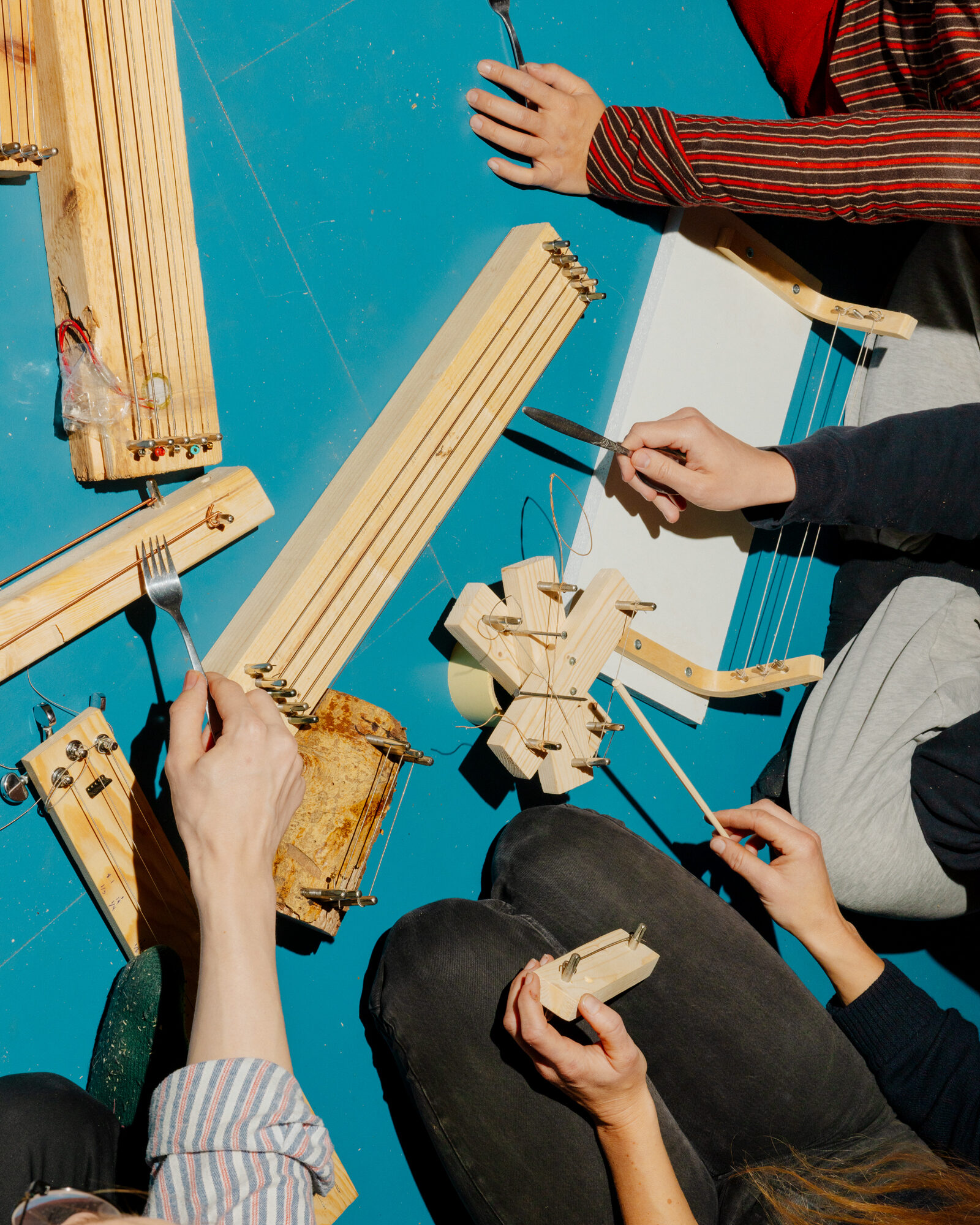
Microtonal Music Studios workshop with Timo Tuhkanen, photo: Tobias Nicolai. Workshops were integral and important element of this year MINU festival; cover photo for this review illustrates the one with Walin Daldo, and Mike McCormick or Harry Lehmann led two other.
Watching this conceptual and performative show I am partially distracted, as Harry Lehmann on my right is heroically fighting with the beer can that lost its ring-pull (his MOOD 30!). In a more relaxed moment I take the chance to ask him about the importance of relational aesthetics nowadays. Even if a German philosopher had problems with finding musical examples to his theory just after he coined it, right now practice confirms it at every step, he says. Jessie Marino, Dalin Waldo and Dylan Richards could sign to this as well. The last one tells me that “relational music” has been important for him for a couple of years. His piece COMPOSITE could be read as a diary of a composer writing a new piece, with a lot of references to his background (metal reminiscences) or MINU festival itself (naming the sponsors). But it is also a kind of ADHD-driven show by percussionist Lorenzo Colombo, who competes with the video image of himself in many ways. So the “composite” here seems to be not only an amalgam of many faces of the author himself, but also of two characters needed for music: composer and performer.
“Let’s say it again –
– one more time –
– the city in the middle of the lakes –
is this a destination?
OH IT’S ALRIGHT
[…]
We started on the Blue ridges – unbelievable – curving blue and light blue and grey blue, and blue blue and navy (blue) and cerulean (blue) all layered and becoming the fault line of the one before.
Roanoake, Asheville, Banners Elk, Clemson, Greenville, Traveller’ Rest – – unbelievable –
Boone County, Jackson, Swain, Hendersen, Transylvania
TRANSYLVANIA – HAHAHA – NO KIDDING!
She was always looking for a good time.” (Jessie Marino, Occasion)
It becomes even more clear when watching Jessie Marino. She performs twice: with a piece from her album A Host of Possible Dramas and Exchanges and with Lamb of Tartary written for Andreas Borregaard. Both owe a lot to some texts: Robert Ashley and Athanasius Kircher respectively. MOOD 100. Automatic writing of Perfect Lives led the way to her Occasion, a surreal story of a not so successful trip to Chicago with a lot of undertones. It got electronic beats and glitches, as well as some distortion effects used to create a sense of dialogue between two characters – but above all it got Marino’s charm and charisma. You could listen to it on bandcamp once and again, but it makes sense only live.
The same with absurd research on the one of motifs explored by 16Ith century Jesuit (prominent figure in our issue #24, “Avant-Avant-garde” by the way). Relational music indeed. Lamb of Tartary becomes another composite or a pretext for skillfull early music arrangements for violin (Marino) and accordion (Borregaard), vintage illustrations in video or hypnotic ostinatos and repetitions. This latter element links it with the Becoming Glass game by Sejersdahl played at the same concert, as both have a lot to do with automatic generating of text. Another one who deploys AI technology at MINU is Weston Olencki, whose virtuoso gig at amplified and processed banjo falls deep into my memory. He is accompanied by the synthesised voice, created from a database of samples by the greatest singers of country and bluegrass. It is like playing with ghosts, ghosts in the machine. But it also adds some warmth and depth to the DIY electronic setup.
Imagine you are making yet another concert with the instrument you know so well. You played it for so many hours and you prepared it and amplified it with contact mics, transducers, railroad spikes and so on. Banjo. You just checked everything again before the gig and the local sound engineer is just great. So you let the public in and you start. And then, fifteen or twenty minutes later, you realise something goes wrong. There is no feedback, the music lacks several layers. You keep checking all the plugins and cables. Nobody else is noticing though. They don’t know your sound. You could just pretend and carry on. Or you could fix the glitch. Carry or fix?
FIX
You loop everything on comp, then you run to the backstage, bring another wire, bite it with your teeth, exchange the old one. And nothing happens. So you signal to the sound engineer, but he can’t help you from behind the console. Do you play as if nothing happened or do you stop?
STOP.
You stop the performance. Together you try to fix things, once again check all in and outs. Someone shouts: “you don’t fuck with ghosts!” Finally you find the box that doesn’t work and you could replace it with another one. You start everything over, and the difference is powerful. Dense, multilayered texture of timbres. Banjo expands in the reverb. Everyone sights in relief.
So you made your choice, Weston. And it is glorious. MOOD 90. Even if it is difficult to maintain or build the dramatic development then. The culmination comes too fast, in my personal opinion. But I still could listen to the whole thing once again, with a fresh ear, when you are touring Poland next weekend. Should I make it? Go or leave? So many options in this game. Does it have an end at all?
Author’s travel and accommodation costs were covered by MINU festival


